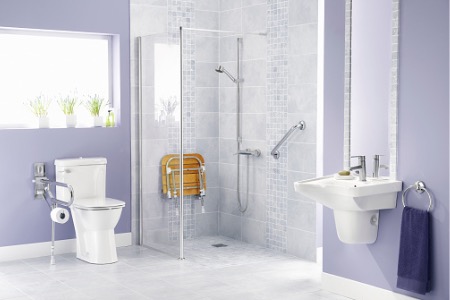
There are many reasons to search for an accessible home. Whether you have a need for more mobility, are caring for an aging parent or plan on aging in place one day yourself, it is crucial to have a home that is barrier-free. Some homes will already be perfectly suited to accommodate homeowners, of all abilities, but others will need a little improvement before they get there. Below, find out what features you should keep an eye out for when searching and discover what can be changed in a house to make it more accessible.
Finding a Move-In Ready Home
Some homes already incorporate elements of universal design, which has fewer barriers for people who use a wheelchair or other mobility devices. An accessible home may have features such as wider hallways and doors, low-threshold doors, hard floors and low storage space that’s easy to access. Even features such as a front-load washing machine, rocker-style light switches, and lever-style doorknobs make a home more accessible.
If you know what features to look for, it’s possible to look for homes yourself, but working with a realtor is a good way to simplify your property search and find a home with the features you need.
What Renovations Make a Home Accessible
If you aren’t able to find a home that has all the features you want, don’t give up. Many homes can be renovated so they check all your boxes. Some modifications can be done quickly, such as changing out light switches or doorknobs. Others are more costly and time-consuming, such as installing a stairlift, putting in a curb-less shower or building a ramp at the front door.
Changing the flooring is one of the most common renovations for making a home more accessible. Many homes feature carpeting that’s not only hard to maneuver on, but hard to keep looking clean. Hardwood floors, on the other hand, are durable and easy to maintain.
It can cost between $2,499 to $6,745 to install new hardwood floors in a home, but the price depends on the size of the area you’re reflooring, as well as the materials you choose. As HomeAdvisor points out, exotic woods like mahogany or Brazilian walnut are more expensive, while oak or teak floors fall more in the mid-range.
It can cost a lot to modify a home, but keep in mind that putting in universally-accessible features can boost its resale value. For example, MillionAcres says that hardwood floors can add 2.5 percent to your home’s value, and you can expect to get at least a 70 percent return on investment (ROI) in many cases.
How to Finance Home Renovations
Modifying a home can be expensive, especially if you need to renovate more than one area. You can sometimes bargain with a seller to cover the cost of repairs for things that fail a home inspection report. However, renovating to accommodate all abilities doesn’t usually fall into the same category if there’s nothing wrong with the features you’re replacing.
You also might have trouble financing major repairs with a traditional mortgage. Instead, the FHA 203(k) loan or the Sallie Mae HomeStyle Loan may be the right type of financing for you. NerdWallet explains that these loans allow you to pay for structural or cosmetic renovations after closing on a home. Keep in mind that 203(k) loans have somewhat strict rules about the types of renovations you can finance, but HomeStyle loans offer more flexibility.
If you are a veteran with a service-connected disability, be aware that the VA also offers grants that will cover certain types of renovations.
Finding an accessible home is challenging, as the concept of universal design is just catching on. But when a home isn’t perfect as-is, you can often turn it into exactly what you want and need by doing a few modifications.
